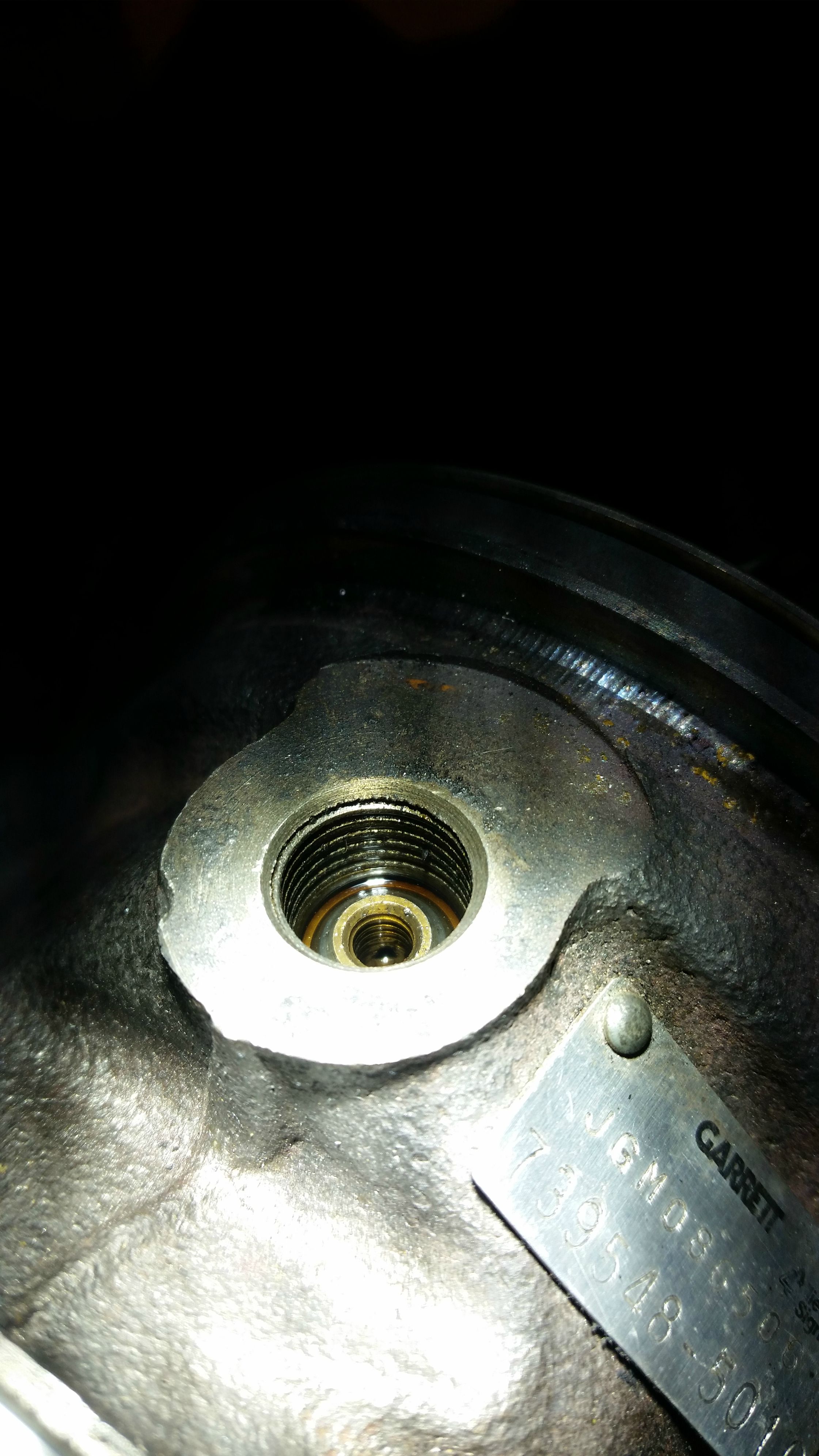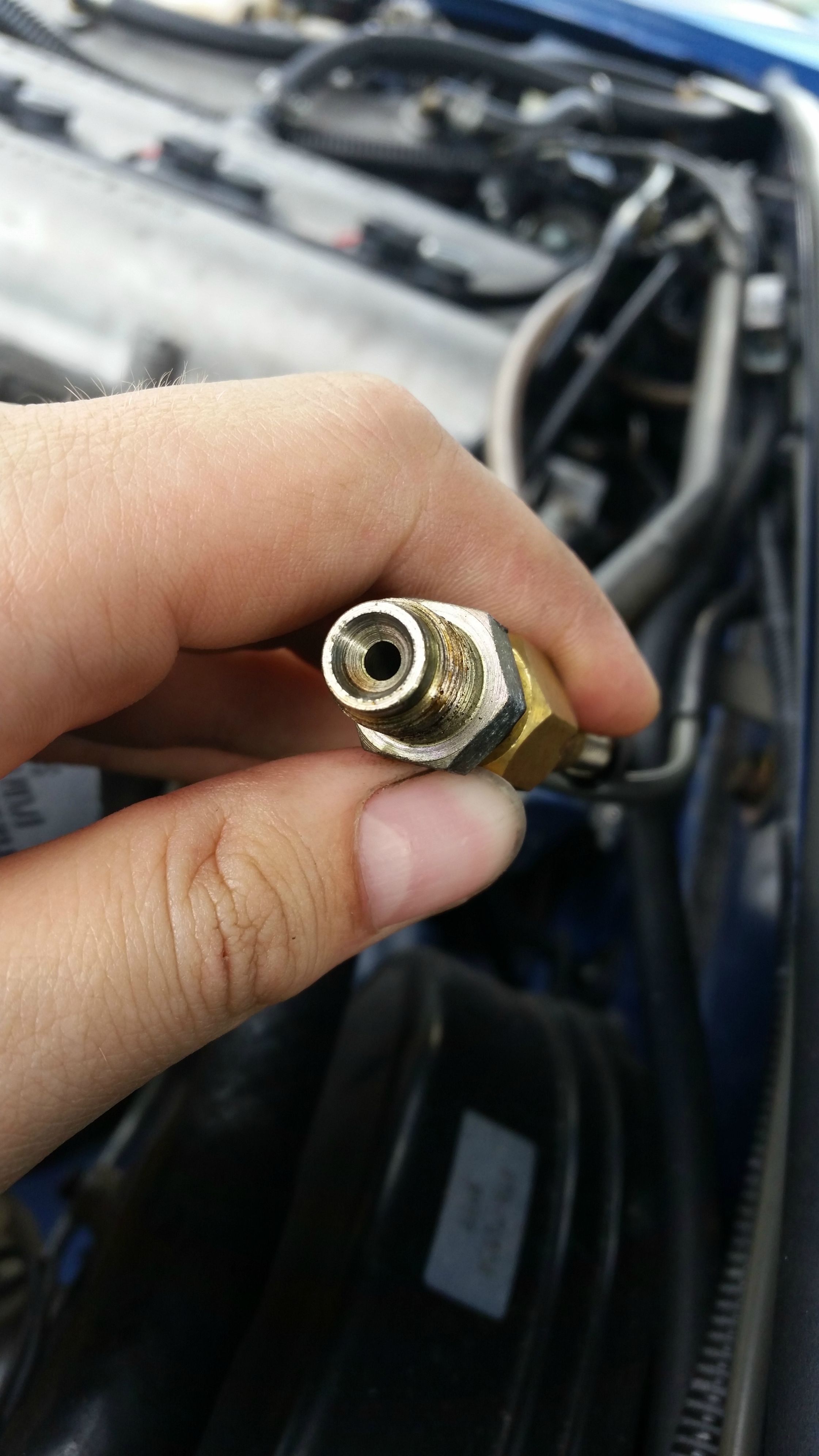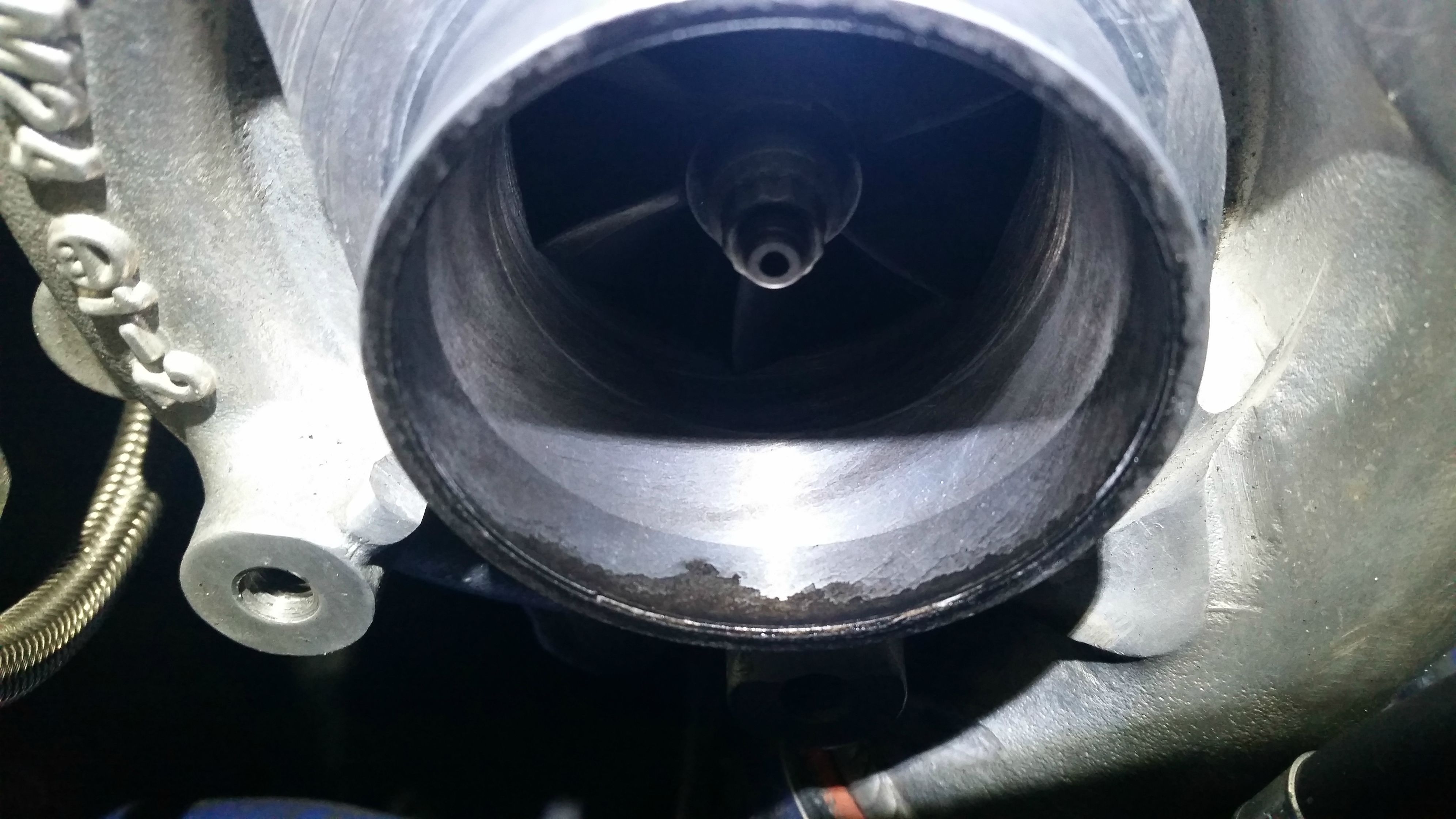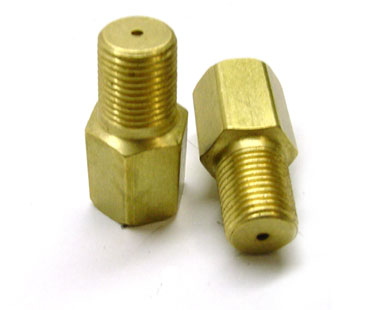Is this an oil restrictor?
#1
Take a close look down in there, I see a tiny opening:

This is the fitting I run going to the oil inlet:

I discovered this after taking the turbo out and disassembling it to exchange the CHRA. Should I be using a restrictor like this?:
-4 size Oil inlet fitting for GT28/30/35R with built-in restrictor : atpturbo.com
or just keep it the way it is? I don't have any smoke or any other signs of over-oiling the turbo... the reason for the CHRA swap is shaft play.

This is the fitting I run going to the oil inlet:

I discovered this after taking the turbo out and disassembling it to exchange the CHRA. Should I be using a restrictor like this?:
-4 size Oil inlet fitting for GT28/30/35R with built-in restrictor : atpturbo.com
or just keep it the way it is? I don't have any smoke or any other signs of over-oiling the turbo... the reason for the CHRA swap is shaft play.
Last edited by Mech5700; 03-17-2015 at 07:19 PM.
#4
The doohickey that's deep in the bowels of the turbos itself is not a restrictor per se; it is a locating pin for the BB cartridge. The pin does have an oil supply hole in it, but it is oversized (by design). Most cars need an oil restrictor upstream of this pin to knock the oil pressure down to a BB-appropriate level. Otherwise the oil pressure can overwhelm the turbo's oil seals and result in leakage on the compressor and/or turbine sides.
BB turbos need no more than ~40-45 psi max oil pressure at the locating pin. More than this introduces additional windage in the bearing. Get too rowdy with the oil pressure and you can negate the BB's spoolup advantage.
Tial Sport makes (or used to make, anyway) restrictor fittings for BB turbos in 0.030" and 0.040" flavors. ATP's restrictor is (I think) 0.035". Best to verify this. The fitting in the OP's second photo is not a restrictor.
Anyway, if you don't want to bother with measuring the oil pressure supplied to the pin, start with the larger of the Tial restrictors. If you observe oil leakage on the comp/turb side(s), step down to the next smaller restrictor, and so on.
BB turbos need no more than ~40-45 psi max oil pressure at the locating pin. More than this introduces additional windage in the bearing. Get too rowdy with the oil pressure and you can negate the BB's spoolup advantage.
Tial Sport makes (or used to make, anyway) restrictor fittings for BB turbos in 0.030" and 0.040" flavors. ATP's restrictor is (I think) 0.035". Best to verify this. The fitting in the OP's second photo is not a restrictor.
Anyway, if you don't want to bother with measuring the oil pressure supplied to the pin, start with the larger of the Tial restrictors. If you observe oil leakage on the comp/turb side(s), step down to the next smaller restrictor, and so on.
#6
JK: thanks, that clarifies things, I couldn't find a definitive answer anywhere. What I find odd is that there is no signs of over pressuring the CHRA. The only oil I saw that I couldn't explain was in the mouth of the compressor inlet (note, I do not have the valve cover breather routed pre-turbo). I didn't have any oil leaking externally from the turbo, or oil smoking out of the exhaust.

Also, what is the actual max oil pressure that a stock pump in a 99 can produce? Is it possible that it just doesn't pump enough pressure to require a smaller restriction?
Brain: I'm shining a light down on it. That little hole is the only path for oil, the bottom of the "pin" is flat, no holes.

Also, what is the actual max oil pressure that a stock pump in a 99 can produce? Is it possible that it just doesn't pump enough pressure to require a smaller restriction?
Brain: I'm shining a light down on it. That little hole is the only path for oil, the bottom of the "pin" is flat, no holes.
#12
Yes and no. The locating pin does have small oil passages incorporated into it, but it's not intended as "a restrictor". Generally most cars need an "additional" oil restrictor upstream of the locating pin of the BB CHRA.
Take the OP, for example - if you're leaking oil into the comp inlet (and you have a proper oil drain layout and the turbo isn't angled at >20 degrees, etc etc), then there's probably too much oil pressure reaching the CHRA's locating pin and you need a restrictor.
Take the OP, for example - if you're leaking oil into the comp inlet (and you have a proper oil drain layout and the turbo isn't angled at >20 degrees, etc etc), then there's probably too much oil pressure reaching the CHRA's locating pin and you need a restrictor.
#14
Found this on Garrett's site:
Q. Does my turbo require an oil restrictor?
A. Oil requirements depend on the turbo's bearing system type. Garrett has two types of bearing systems; traditional journal bearing; and ball bearing. The journal bearing system in a turbo functions very similarly to the rod or crank bearings in an engine. These bearings require enough oil pressure to keep the components separated by a hydrodynamic film. If the oil pressure is too low, the metal components will come in contact causing premature wear and ultimately failure. If the oil pressure is too high, leakage may occur from the turbocharger seals. With that as background, an oil restrictor is generally not needed for a journal-bearing turbocharger except for those applications with oil-pressure-induced seal leakage. Remember to address all other potential causes of leakage first (e.g., inadequate/improper oil drain out of the turbocharger, excessive crankcase pressure, turbocharger past its useful service life, etc.) and use a restrictor as a last resort. Garrett distributors can tell you the recommended range of acceptable oil pressures for your particular turbo. Restrictor size will always depend on how much oil pressure your engine is generating-there is no single restrictor size suited for all engines. Ball-bearing turbochargers can benefit from the addition of an oil restrictor, as most engines deliver more pressure than a ball bearing turbo requires. The benefit is seen in improved boost response due to less windage of oil in the bearing. In addition, lower oil flow further reduces the risk of oil leakage compared to journal-bearing turbochargers. Oil pressure entering a ball-bearing turbocharger needs to be between 40 psi and 45 psi at the maximum engine operating speed. For many common passenger vehicle engines, this generally translates into a restrictor with a minimum of 0.040" diameter orifice upstream of the oil inlet on the turbocharger center section. Again, it is imperative that the restrictor be sized according to the oil pressure characteristics of the engine to which the turbo is attached. Always verify that the appropriate oil pressure is reaching the turbo. The use of an oil restrictor can (but not always) help ensure that you have the proper oil flow/pressure entering the turbocharger, as well as extract the maximum performance.
Now we already know most of this, but how does one determine the proper restrictor size? Garrett says a min of .040" buuuuut
ATP is .035"
-4 size Oil inlet fitting for GT28/30/35R with built-in restrictor : atpturbo.com
and TiAL is .030" or .040"
TiAL® Oil Restrictor Fittings for GT Ball Bearing Turbos - GT28R, GT28RS, GT30R, GT35R
Does anyone know what our max oil pressure is on a stock oil pump?
Q. Does my turbo require an oil restrictor?
A. Oil requirements depend on the turbo's bearing system type. Garrett has two types of bearing systems; traditional journal bearing; and ball bearing. The journal bearing system in a turbo functions very similarly to the rod or crank bearings in an engine. These bearings require enough oil pressure to keep the components separated by a hydrodynamic film. If the oil pressure is too low, the metal components will come in contact causing premature wear and ultimately failure. If the oil pressure is too high, leakage may occur from the turbocharger seals. With that as background, an oil restrictor is generally not needed for a journal-bearing turbocharger except for those applications with oil-pressure-induced seal leakage. Remember to address all other potential causes of leakage first (e.g., inadequate/improper oil drain out of the turbocharger, excessive crankcase pressure, turbocharger past its useful service life, etc.) and use a restrictor as a last resort. Garrett distributors can tell you the recommended range of acceptable oil pressures for your particular turbo. Restrictor size will always depend on how much oil pressure your engine is generating-there is no single restrictor size suited for all engines. Ball-bearing turbochargers can benefit from the addition of an oil restrictor, as most engines deliver more pressure than a ball bearing turbo requires. The benefit is seen in improved boost response due to less windage of oil in the bearing. In addition, lower oil flow further reduces the risk of oil leakage compared to journal-bearing turbochargers. Oil pressure entering a ball-bearing turbocharger needs to be between 40 psi and 45 psi at the maximum engine operating speed. For many common passenger vehicle engines, this generally translates into a restrictor with a minimum of 0.040" diameter orifice upstream of the oil inlet on the turbocharger center section. Again, it is imperative that the restrictor be sized according to the oil pressure characteristics of the engine to which the turbo is attached. Always verify that the appropriate oil pressure is reaching the turbo. The use of an oil restrictor can (but not always) help ensure that you have the proper oil flow/pressure entering the turbocharger, as well as extract the maximum performance.
Now we already know most of this, but how does one determine the proper restrictor size? Garrett says a min of .040" buuuuut
ATP is .035"
-4 size Oil inlet fitting for GT28/30/35R with built-in restrictor : atpturbo.com
and TiAL is .030" or .040"
TiAL® Oil Restrictor Fittings for GT Ball Bearing Turbos - GT28R, GT28RS, GT30R, GT35R
Does anyone know what our max oil pressure is on a stock oil pump?
#18
I think there were multiple factors giving me that slow spool. The leaking bypass valve made the biggest difference. Unfortunately the night I installed the new bov a few months back, I got busted in the middle of a 5th gear pull... not fun. So I haven't been able to do a full pull to record my current spool data. Been driving like a granny... By feel tho, it is definitely way better than before.
Thread
Thread Starter
Forum
Replies
Last Post
stoves
Suspension, Brakes, Drivetrain
5
04-21-2016 04:00 PM
JesseTheNoob
DIY Turbo Discussion
15
09-30-2015 03:44 PM















